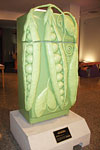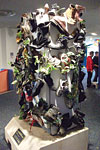
Creating works of art out of old refrigerators (above and below) is one way to keep inefficient refrigerators that could be safety hazards out of circulation without having to send them to the junk heap.
I’m not going to pretend to understand what the artists were trying to “say” but the project - which included three “statements” at a children’s museum (The Discovery Center of Rockford, Ill.) near where I live - did bring out important points about efficiency and environmental awareness; and, for me, safety.

And obviously a work of art is not going to end up in some landfill or junk yard - which has to make environmentalists happy.
The safety issue strikes home for me. For many years the Refrigeration Service Engineers Society Auxiliary (RSESA) had a campaign called TOD (Take off The Doors) encouraging contractors who came across old decommissioned refrigerators to remove the doors before placing them at curbside for eventual pickup and disposal. Those old refrigerators latched and the tragic problem was that children would sometimes play in them, get caught if the door latched and suffocate. (Frankly I have a similar concern for the newer refrigerators. Even though the doors can be pushed open from the inside, it might not be all that easy for a small, scared child.)

So, here’s the deal. I went to look at the refrigerator artwork because I’m a refrigeration guy and I was curious. I ended up being more aware than ever about the need for safety in dealing with any piece of equipment - for both service technicians and end-users.
I hope any of us who is near a piece of HVACR equipment thinks safety first and foremost.
Publication date:12/06/2010

Report Abusive Comment